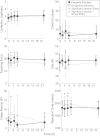Smoked cannabis' psychomotor and neurocognitive effects in occasional and frequent smokers
- PMID: 25745105
- PMCID: PMC4416120
- DOI: 10.1093/jat/bkv012
Smoked cannabis' psychomotor and neurocognitive effects in occasional and frequent smokers
Abstract
Δ9-Tetrahydrocannabinol (THC), the primary psychoactive constituent in cannabis, impairs psychomotor performance, cognition and driving ability; thus, driving under the influence of cannabis is a public safety concern. We documented cannabis' psychomotor, neurocognitive, subjective and physiological effects in occasional and frequent smokers to investigate potential differences between these smokers. Fourteen frequent (≥4x/week) and 11 occasional (<2x/week) cannabis smokers entered a secure research unit ∼19 h prior to smoking one 6.8% THC cigarette. Cognitive and psychomotor performance was evaluated with the critical tracking (CTT), divided attention (DAT), n-back (working memory) and Balloon Analog Risk (BART) (risk-taking) tasks at -1.75, 1.5, 3.5, 5.5 and 22.5 h after starting smoking. GLM (General Linear Model) repeated measures ANOVA was utilized to compare scores. Occasional smokers had significantly more difficulty compensating for CTT tracking error compared with frequent smokers 1.5 h after smoking. Divided attention performance declined significantly especially in occasional smokers, with session × group effects for tracking error, hits, false alarms and reaction time. Cannabis smoking did not elicit session × group effects on the n-back or BART. Controlled cannabis smoking impaired psychomotor function, more so in occasional smokers, suggesting some tolerance to psychomotor impairment in frequent users. These data have implications for cannabis-associated impairment in driving under the influence of cannabis cases.
Published by Oxford University Press 2015. This work is written by (a) US Government employee(s) and is in the public domain in the US.
Figures





References
-
- 2014) United Nations Office on Drugs and Crime, World Drug Report 2014, https://www.unodc.org/documents/wdr2014/World_Drug_Report_2014_web.pdf (accessed December 2014).
-
- Drummer O.H., Kourtis I., Beyer J., Tayler P., Boorman M., Gerostamoulos D. (2012) The prevalence of drugs in injured drivers. Forensic Science International, 215, 14–17. - PubMed
-
- 2009) 2007 National Roadside Survey of Alcohol and Drug Use by Drivers: Drug Results. National Highway Traffic Safety Administration Office of Behavioral Safety Research; http://www.nhtsa.gov/Driving+Safety/Research+&+Evaluation/ci.2007+Nation... (Accessed September 2014).
Publication types
MeSH terms
Grants and funding
LinkOut - more resources
Full Text Sources
Other Literature Sources
Medical

